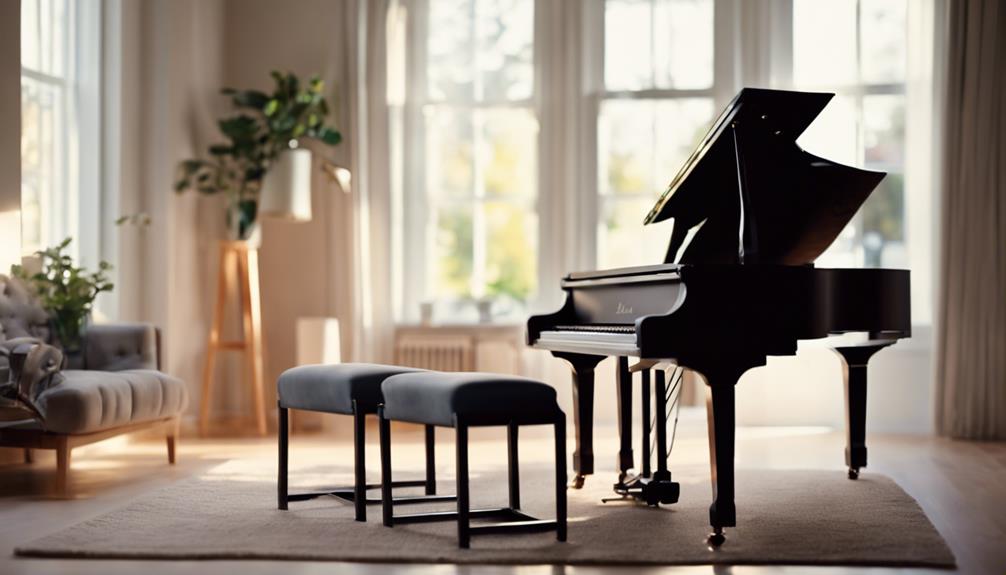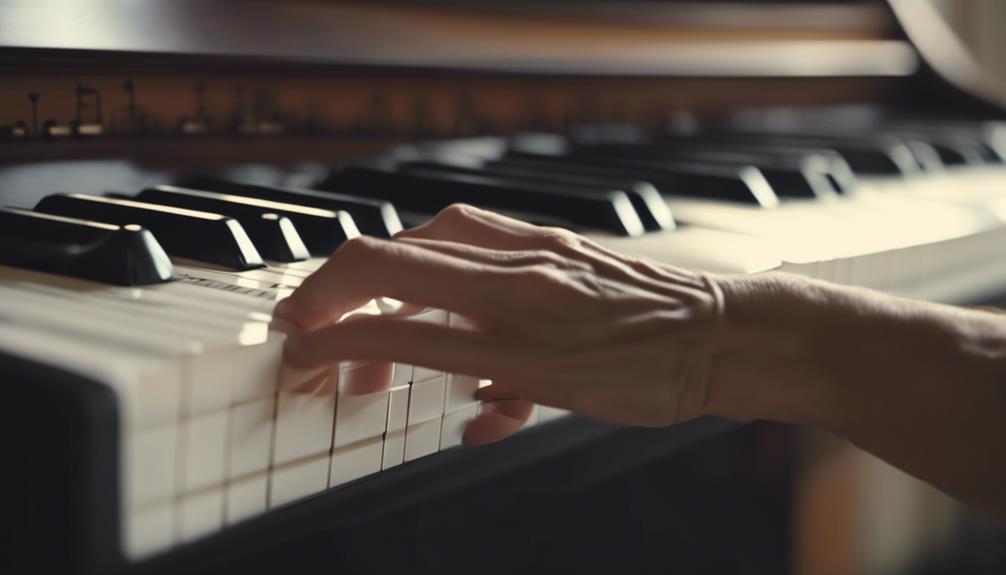Teaching yourself piano might seem challenging at first, but with a structured approach, you can make significant progress.
Start by acquiring a piano or keyboard with at least 61 keys, then familiarize yourself with the layout and hand positioning. As you gain comfort with these basics, you’ll want to explore music theory and sheet music to deepen your understanding.
Setting specific practice goals and exploring different genres will keep your practice sessions engaging. How do you effectively incorporate these elements into your routine?
Let’s explore the next steps to guarantee a successful self-teaching journey.
TL-DR
- Memorize the piano’s layout and key names to navigate the keyboard effectively.
- Practice proper hand positioning and finger exercises to build dexterity and muscle memory.
- Learn basic music theory, including scales, chords, and key signatures for foundational knowledge.
- Use ear training tools to develop the ability to identify pitches, intervals, and chords by ear.
- Set specific practice goals and use a practice journal to track progress and stay motivated.
Get a Piano or Keyboard

Start your piano learning journey by getting a piano or keyboard with at least 61 keys. As a beginner, having the right instrument is important to your learning experience.
A digital piano with weighted keys can give you a more authentic feel, similar to an acoustic piano. This feature helps you develop proper finger strength and technique, which is essential as you progress.
If you’re on a budget, don’t worry. There are plenty of affordable portable keyboards and MIDI controllers that are perfect for beginners. These options aren’t only budget-friendly but also space-saving, making them ideal if you have limited room.
Another practical option is to explore renting a piano or keyboard. This can be a cost-effective way to start learning without making a significant upfront investment. Many music stores offer rental programs that allow you to try out different models before committing to a purchase.
Learn the Piano Layout
To get comfortable with the piano, start by recognizing the names and positions of the keys. Notice how the black keys are grouped in twos and threes, which helps you identify the white keys.
Understanding octaves and intervals will also make it easier to navigate the entire keyboard.
Key Names and Positions
Ever wondered how the piano’s 88 keys are organized to create beautiful music? Understanding the key names and positions is essential when you’re learning piano. The white keys represent natural notes: C, D, E, F, G, A, and B. The black keys are the accidentals, which are sharps and flats. Knowing these key names helps you move around the keyboard effortlessly, ensuring you play melodies and chords accurately.
To start, memorize the layout of the keys. Position yourself so you can identify the notes without constantly looking down. This enhances your playing efficiency. Use beginner resources like flashcards and apps to reinforce your understanding of key names and positions.
Practicing finger placement is vital. Proper finger placement not only helps you play more fluidly but also reduces strain, making your practice sessions more effective.
Learning piano effectively involves mastering these basics. Knowing where each note is on the keyboard is fundamental for playing by ear, understanding scales, and building chords. With regular practice and the right resources, you’ll find yourself gliding across the keys with ease.
Octaves and Intervals
Understanding octaves and intervals is crucial for mastering the piano’s layout and enhancing your musical skills. An octave spans 12 half steps, from one note to the same note at a higher or lower pitch. Knowing this helps you navigate the keyboard efficiently.
Intervals, the distances between two notes, come in various types such as major, minor, perfect, diminished, and augmented. Grasping these concepts enriches your understanding of the piano’s musical structure.
Practicing octaves and intervals isn’t just theoretical; it greatly improves your hand coordination and finger flexibility. When you play octave scales and interval exercises, you develop the dexterity needed for intricate pieces. This practice directly contributes to your overall piano proficiency, making complex melodies, harmonies, and chords easier to play.
To start, try playing simple octave scales, ensuring each note is clear and even. Then, move on to interval exercises, focusing on the different types. As you become more comfortable, increase the tempo and complexity. This step-by-step approach solidifies your foundation, paving the way for more advanced techniques.
Understanding and mastering octaves and intervals will make your journey to piano proficiency smoother and more enjoyable.
Black and White Keys
The piano’s 88 keys, divided into white and black keys, form a distinctive pattern that helps you quickly identify notes and traverse the keyboard. The white keys represent the natural notes A through G, while the black keys stand for the sharps and flats.
This arrangement of keys isn’t random but follows a specific pattern: groups of two black keys are followed by groups of three black keys. This repetitive pattern is important for recognizing note positions and aids greatly in playing.
When you’re learning the piano, understanding this layout is essential. The black keys help you locate notes swiftly. For instance, the note C is always found just to the left of a group of two black keys, while F is located to the left of a group of three black keys. This knowledge helps in traversing the piano keyboard smoothly and efficiently.
Developing muscle memory and finger placement becomes easier as you familiarize yourself with the arrangement of the black and white keys. This understanding enhances your proficiency and confidence in playing. By mastering the piano layout, you’ll find it simpler to play various musical pieces, ultimately making your practice sessions more productive and enjoyable.
Master Proper Hand Positioning

To master proper hand positioning on the piano, keep your wrists level with the keys and your fingers curved. This positioning is essential for fluid playing and preventing strain.
Avoid tension in your hands and shoulders to maintain a relaxed posture. Place your fingers on the keys using your fingertips to guarantee accuracy and control.
Regularly practicing hand positioning exercises can help strengthen your muscles and improve dexterity.
Here are a few tips to enhance your hand positioning:
- Finger Tapping Exercise: Tap each finger on the keys individually, keeping the others relaxed. This helps isolate finger movements and builds strength.
- Five-Finger Scale: Play a simple five-finger scale, ensuring your fingers remain curved and your wrist stays level. This reinforces proper hand positioning while playing.
- Hanon Exercises: These are standard exercises designed to improve finger strength and dexterity. They’re excellent for practicing proper hand positioning.
Understand Basic Music Theory
With your hand positioning skills in place, it’s time to explore the fundamentals of music theory to further enhance your piano playing. Start by learning to identify key signatures, time signatures, and note values. Recognizing these elements will help you understand how different pieces of music are structured.
Next, delve into scales and chords. Scales are sequences of notes that provide the foundation for melodies, while chords are combinations of notes played together to create harmony. Familiarize yourself with major and minor scales, and practice forming basic triads and seventh chords. Understanding these will give you the tools to play more complex music.
The circle of fifths is another essential concept in music theory. It shows the relationships between different key signatures and helps you understand how music modulates from one key to another. This knowledge is important for improvisation and composition.
Additionally, learn about intervals, which are the distances between notes. Recognizing intervals will improve your ability to read music and play by ear. Practice interpreting musical symbols, dynamics, and articulations to add expression to your playing.
Learn to Read Sheet Music

To start, you’ll need to understand how musical notation works, including notes, rhythms, and various symbols.
Focus on practicing note recognition for both the treble and bass clefs.
Understand Musical Notation
Understanding musical notation is essential for learning to read sheet music and play the piano proficiently. Musical notation consists of symbols that represent pitch, duration, and other musical elements. To start, you need to familiarize yourself with the staff, clefs, and notes. Each note on the staff corresponds to a specific pitch and duration, making it important to understand their placement and appearance.
Key signatures and time signatures are also important components. Key signatures indicate the key of the piece, showing which notes are sharp or flat throughout. Time signatures, on the other hand, inform you about the rhythm by specifying how many beats are in each measure and what note value gets a beat.
Sight reading is another significant skill to develop. It involves reading and playing music at first sight, which greatly improves your fluency and confidence.
Here are some tips to help you get started:
- Learn the Basics: Get comfortable with the staff, clefs, and basic note values.
- Understand Key and Time Signatures: Know how they affect the music you play.
- Practice Sight Reading: Start with simple pieces to build your confidence and gradually increase complexity.
Practice Note Recognition
After grasping the basics of musical notation, it’s time to practice note recognition to build your sheet music reading skills. Begin by memorizing the notes on the staff and associating them with the corresponding keys on the piano. This foundational step is essential for any beginner aiming to become proficient in sight-reading.
To reinforce learning, use flashcards, online resources, and beginner books to practice note recognition regularly. These tools will help you quickly identify notes and their positions on both the treble and bass clefs. By focusing on this, you’ll start to improve your sight-reading skills greatly.
Practice naming notes out loud while playing them on the piano. This simultaneous vocal and physical activity helps solidify your understanding and speeds up the learning process.
As you become more comfortable with simple notes, gradually progress to reading more complex sheet music that includes varied note durations and different key signatures.
Master Key Signatures
Mastering key signatures is essential for reading sheet music accurately and understanding the overall structure of a piece. When you’re learning to play the piano, knowing your key signatures helps you identify the sharps and flats that appear consistently throughout the piece. This knowledge will make reading music much smoother and improve your sight-reading skills.
Here are three steps to help you master key signatures:
- Memorize the Order of Sharps and Flats: For sharps, remember F-C-G-D-A-E-B. For flats, use B-E-A-D-G-C-F. Mnemonic devices like ‘Father Charles Goes Down And Ends Battle’ for sharps and ‘BEAD Greatest Common Factor’ for flats can be handy.
- Understand Major and Minor Key Relationships: Each major key has a relative minor key that shares the same key signature. For example, C major and A minor both have no sharps or flats. Recognizing these relationships will deepen your understanding of key signatures.
- Practice Identifying Key Signatures: Spend time regularly identifying key signatures in different pieces of sheet music. This practice will enhance your sight-reading abilities and make you more fluent in recognizing key signatures.
Practice Basic Scales
To build finger strength and dexterity, start practicing basic scales like C major, G major, and D major. These scales are foundational for developing good technique and accuracy. Begin with the C Major scale, as it’s entirely composed of white keys, making it easier to navigate. Focus on mastering the correct fingering for each scale to make sure you’re building proper muscle memory.
Incorporate a metronome into your practice to maintain a steady tempo. Start slow and gradually increase the speed as you become more comfortable. This approach helps you develop fluency and precision in your playing. Consistent, daily practice is essential; even just 10-15 minutes a day can lead to significant improvement over time.
While practicing, pay attention to the shifts between notes and make certain each one is played clearly and evenly. This will enhance your overall technique and finger strength.
As you progress, try playing scales and chords together to deepen your understanding of their relationship. Remember, patience and consistency are key. By dedicating time to these basic scales, you’ll lay a strong foundation for more advanced piano skills in the future.
Play Simple Chords

Now that you’re comfortable with basic scales, it’s time to learn simple chords. Start with basic major and minor chord shapes like C, F, and G, and practice moving smoothly between them.
Focus on coordinating both hands to form these chords and create simple progressions.
Basic Chord Shapes
Understanding basic chord shapes like C major, G major, and D major is essential for starting to play simple songs on the piano. To learn how to play these chords, you need to focus on finger positioning and smooth switching between chords. Chord diagrams can be incredibly helpful in visualizing where your fingers should go on the keys.
- Learn Basic Chord Shapes:
Start by familiarizing yourself with the most common chords: C major, G major, and D major. Use chord diagrams to see the exact positioning of your fingers. For example, in a C major chord, your thumb should be on C, your middle finger on E, and your pinky on G.
- Finger Positioning:
Proper finger positioning is essential for playing chords effortlessly. Make sure each finger presses its assigned key firmly, but without tension. Practicing this will help you avoid unnecessary strain and improve your accuracy.
- Switching Between Chords:
Practice switching between chords smoothly. Start slow, then gradually increase your speed as you become more comfortable. Consistent practice will make these switches feel natural, allowing you to maintain a steady rhythm.
Incorporate these steps into your practice routine to build a strong foundation in piano playing.
Chord Progression Practice
Begin your chord progression practice by focusing on simple sequences like C major to F major to G major. These basic chord progressions are important for building foundational skills. Start by mastering each chord individually, and then practice moving smoothly between them. This will enhance your overall playing technique and improve the sound of your music.
Utilize online resources and tutorials to learn common chord progressions and their variations. Many websites and videos offer step-by-step instructions that can guide you through different sequences. As you become more comfortable, experiment with different rhythms and strumming patterns. This variety will help you understand how rhythm impacts the feel of a progression.
Pay special attention to your shifts between chords. Smooth shifts are essential for maintaining the flow of a piece. Practice slowly at first, and gradually increase your speed as you become more confident.
Track your progress by recording yourself playing these chord progressions. Listening to your recordings can help you identify areas that need improvement. Regular progress tracking won’t only show you how far you’ve come but also highlight specific aspects to focus on in your practice sessions.
Hands Coordination Techniques
Start improving your hand coordination by practicing simple chords with both hands simultaneously. Begin with basic chords like C major and G major. These chords are foundational and will help you build the necessary hand coordination skills. Use visual aids or chord diagrams to understand the finger placement for each chord.
To develop muscle memory and smooth changes, focus on playing each chord evenly and smoothly. It’s important to make sure that both hands are synchronized.
Here are some steps to guide you:
- Identify Finger Placement: Look at a chord diagram to see where each finger should go. Place your fingers on the keys accordingly.
- Practice Basic Chords: Start with C major and G major. Play these chords repeatedly until you feel comfortable with the hand coordination.
- Smooth Transitions: Once you master basic chords, work on changing between them. Practice chord progressions slowly, then gradually increase the speed.
Train Your Ear
Training your ear is essential for anyone looking to play the piano by ear and truly understand music. Start by practicing identifying different pitches by ear. This helps you recognize the significant differences in sound, an important skill for playing by ear.
Next, train your ear to recognize intervals and chords. Listen to music and try to replicate the intervals and chords you hear on the piano. This practice will bolster your ability to understand and play harmonies.
Use online ear training tools and apps to enhance your skills. These tools offer exercises that can help you improve your pitch recognition and interval identification. They’re convenient and effective for daily practice.
Another important aspect is improvisation. Experiment with playing melodies and songs by ear. This not only improves your ear but also your creativity and confidence in playing without sheet music.
Develop Finger Dexterity

Now that you’ve honed your ear for music, it’s time to focus on developing finger dexterity to enhance your piano playing skills. Working on finger strength and coordination will allow you to play more complex pieces with ease.
Here are three key strategies to help you build dexterity:
- Daily Practice of Scales and Arpeggios:
Practicing scales and arpeggios daily is essential. They improve finger strength and agility, helping you navigate the keyboard smoothly. Start slow and gradually increase your speed as you become more comfortable.
- Finger Exercises:
Incorporate exercises like Hanon exercises into your routine. These exercises are specifically designed to enhance finger strength, finger placement, and overall hand coordination. Make sure your finger placement is accurate to develop muscle memory.
- Hand Independence Exercises:
To improve coordination between your hands, practice hand independence exercises. These exercises train each hand to operate independently, an important skill for playing more intricate piano pieces. Start with simple patterns and gradually increase the complexity.
Set Practice Goals
Setting clear and achievable practice goals is essential for making consistent progress in your piano journey.
First, set specific practice goals, whether it’s learning a new song, mastering a challenging technique, or improving your sight-reading skills. Breaking down these larger objectives into smaller, manageable tasks helps you track progress and stay motivated.
Allocate dedicated practice time each day to work towards your set goals effectively. Consistency is key, and having a fixed time for practice guarantees you’re steadily moving towards your objectives.
To maximize your efforts, use a practice journal or tracker. Document your daily practice sessions, note areas for improvement, and record what you’ve accomplished. This will give you a clear picture of your progress over time.
Don’t forget to celebrate milestones. When you achieve a small goal, such as playing a difficult piece flawlessly or nailing a tricky rhythm, take a moment to acknowledge your hard work. Celebrating these victories reinforces a positive learning experience and keeps you motivated to tackle the next challenge.
Explore Different Genres

As you set and achieve your practice goals, expanding your repertoire by exploring different genres can enrich your piano skills and keep your learning experience exciting. By diving into various musical styles, you’ll not only broaden your musical knowledge but also enhance your versatility as a pianist.
Here are some genres to get you started:
- Classical: Learning classical pieces by composers like Bach, Beethoven, and Chopin will help you understand traditional music styles. These songs often require precise technique and can improve your finger strength and dexterity.
- Jazz: Teach yourself jazz piano by exploring the works of Bill Evans, Thelonious Monk, and Herbie Hancock. Jazz focuses on improvisation, which can develop your ability to think on your feet and express your creativity.
- Pop and Contemporary: Experiment with pop songs from artists like Adele, Ed Sheeran, and Taylor Swift. These modern pieces often have catchy melodies and can be a fun way to practice chord progressions and rhythm.
Record Your Progress
How can you effectively track your development and stay motivated in your piano journey? One of the best ways is to record your progress. Using technology like recording apps or software, you can capture your playing sessions. Listening back to these recordings allows for self-assessment, enabling you to hear your strengths and pinpoint areas that need improvement.
Documenting your performances can greatly boost your motivation. When you see tangible growth over time, it reinforces your commitment and builds confidence. Analyzing your recordings helps you identify errors and refine techniques, ensuring that you’re continually advancing in your skills.
Set aside regular intervals to record your practice sessions. This not only creates a habit but also provides a structured way to measure your progress. Share your recordings with online communities or friends to gain valuable feedback and encouragement. Constructive criticism from others can offer new perspectives and insights you might’ve missed.
Incorporating these strategies will help you stay focused and motivated. Recording your progress is a powerful tool in your piano journey, allowing you to celebrate your successes and learn from your mistakes. Embrace technology and make it an integral part of your practice routine.
Next up, learn how to play piano by ear in this guide.
